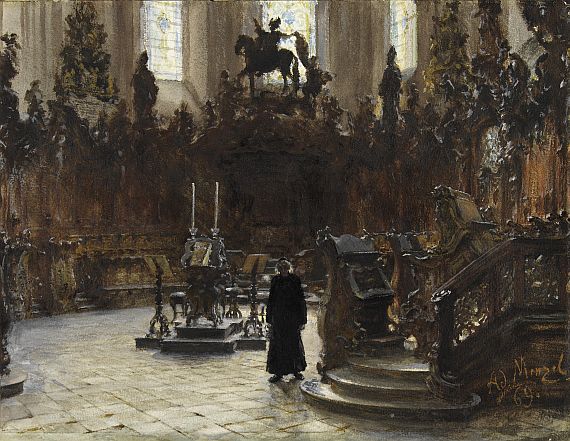Dictionary


French Realism
French Realism, the so-called Réalisme, was decisively coined by three artists: Gustave Courbet, Honoré Daumier and Jean-François Millet. The indisputable main representative and founding father of French Realism as a programmatic concept of art was Gustave Courbet (1819-77). His works, made with the intention to capture reality by doing without any kind of transfiguration and elevation, shocked both critics and audience alike. Today's observers have a hard time understanding why pictures such as the "Begräbnis von Ornans" (Funeral of Ornans, from 1849) caused a commotion in those days: Courbet shows a rural funeral ceremony with representatives from all social classes, their faces unadorned, the composition unaffected, in a format that was actually reserved for great historical depictions. This was nothing less than a revolutionary act, an offence of the audience's conventional habits.
Honoré Daumier (1808-79), on contrary, preferred small formats and the broad effect of the lithography. Daumier, who had also made great achievements as a satirist, captured, unlike Courbet and his sober and realistic view, his surroundings in an often satiric and exaggerated style; his sheets depict human weaknesses and failures. Honoré Daumier also worked as a painter and created expressive works in light atmospheres that call reminiscence of Rembrandt.
Jean-François Millet (1814-75) completed the trinity of French Realism. He turned his art entirely to rural life; his depictions of everyday life scenes posses deep suggestive powers, which gives him the air of a precursor of Symbolism. As a member of the School of Barbizon, Jean-François Millet counts among those artists that laid the path to Impressionism. As it is the case with him, the transitions between Realism, Pleinairism and Impressionism seem to be without borders.
French Realism, the so-called Réalisme, was decisively coined by three artists: Gustave Courbet, Honoré Daumier and Jean-François Millet. The indisputable main representative and founding father of French Realism as a programmatic concept of art was Gustave Courbet (1819-77). His works, made with the intention to capture reality by doing without any kind of transfiguration and elevation, shocked both critics and audience alike. Today's observers have a hard time understanding why pictures such as the "Begräbnis von Ornans" (Funeral of Ornans, from 1849) caused a commotion in those days: Courbet shows a rural funeral ceremony with representatives from all social classes, their faces unadorned, the composition unaffected, in a format that was actually reserved for great historical depictions. This was nothing less than a revolutionary act, an offence of the audience's conventional habits.
Honoré Daumier (1808-79), on contrary, preferred small formats and the broad effect of the lithography. Daumier, who had also made great achievements as a satirist, captured, unlike Courbet and his sober and realistic view, his surroundings in an often satiric and exaggerated style; his sheets depict human weaknesses and failures. Honoré Daumier also worked as a painter and created expressive works in light atmospheres that call reminiscence of Rembrandt.
Jean-François Millet (1814-75) completed the trinity of French Realism. He turned his art entirely to rural life; his depictions of everyday life scenes posses deep suggestive powers, which gives him the air of a precursor of Symbolism. As a member of the School of Barbizon, Jean-François Millet counts among those artists that laid the path to Impressionism. As it is the case with him, the transitions between Realism, Pleinairism and Impressionism seem to be without borders.
Offers
Headquarters
Joseph-Wild-Str. 18
81829 Munich
Phone: +49 89 55 244-0
Fax: +49 89 55 244-177
info@kettererkunst.de
Louisa von Saucken / Undine Schleifer
Holstenwall 5
20355 Hamburg
Phone: +49 40 37 49 61-0
Fax: +49 40 37 49 61-66
infohamburg@kettererkunst.de
Dr. Simone Wiechers / Nane Schlage
Fasanenstr. 70
10719 Berlin
Phone: +49 30 88 67 53-63
Fax: +49 30 88 67 56-43
infoberlin@kettererkunst.de
Cordula Lichtenberg
Gertrudenstraße 24-28
50667 Cologne
Phone: +49 221 510 908-15
infokoeln@kettererkunst.de
Hessen
Rhineland-Palatinate
Miriam Heß
Phone: +49 62 21 58 80-038
Fax: +49 62 21 58 80-595
infoheidelberg@kettererkunst.de
We will inform you in time.




